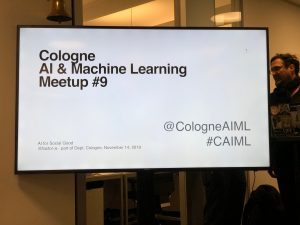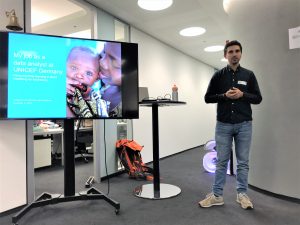CAIML #9 took place on November 14 at factor-a – part of Dept, demonstrating how AI can be used for social good and to address societal challenges.
Applying artificial intelligence for social good
Launching #CAiML no9 by @fabianhadiji at Factor-A in #Köln @CologneAIML #AI #ML #MachineLearning #KI in #Cologne @MM2de @goedle_io pic.twitter.com/savgvQe2X6
— Thomas Fabula (@TFConsult) November 14, 2019
Food insecurity prediction using neural networks
Gernot Heisenberg (Professor at Technische Hochschule Köln): Combining socio-economic and remote sensing data for food insecurity prediction using neural networks
“Aid organizations and governments are applying great effort in resolving the negative impacts of food insecurity induced crisis like famines or mass migration. One of the most limiting resources these actors face is the lack of preparation time for consistent and sustainable planning for emergency relief like setting refugee camps or securing supply with food and energy.
Hence, increasing the lead time for preparation is an essential step and will result in saving many lives. The aim of this research is to increase the lead time by developing a ML based mathematical prediction model that is able to compute the probability for food insecure areas by learning from historical data. For performing such computations, our prediction model is developed and trained on historic open access data for the Horn of Africa (2009-2018).
We used precipitation and vegetation data derived by remote sensing, as well as socio-economic, medical, armed conflict and disaster data. To overcome spatial inconsistencies in the input data and to meet the requirements of spatially homogenous input for neural networks, all data has been converted to geo-referenced raster maps. Disaster and armed conflict data has been fitted to districts while local food market prices have been interpolated. The IPC has been used as the food security label.
In order to find a prediction model, deep learning methods have been used. Several analyses were applied on the collected data such as multicollinearity checks and principal component analyses. Preliminary cross-validated results have encouraged us to further investigate the detection of food insecure areas using open access data.”
Machine learning in direct marketing for fundraising
Alexander Merdian-Tarko (Data Analyst at German Committee for UNICEF e.V.): My job as a data analyst at UNICEF Germany – Using machine learning in direct marketing for fundraising
“Data can be of immense importance for aid organizations like UNICEF, especially when it comes to raising funds for humanitarian projects and understanding donor needs and preferences. Therefore, leveraging the potential of data for our work at UNICEF Germany is one of the central pillars in our organization’s strategy. This endeavor is a complex, lengthy process that encompasses all teams and departments within our organization.
The aspects of a successful data strategy comprise a variety of important and exciting topics, such as privacy protection, data security, data governance and quality, IT infrastructure and ML applications. The main objective of utilizing the potential of data for our work as an aid organization is to use it in a way that enables us to better support children in need, optimally serve donor needs and responsibly, transparently and efficiently allocate limited resources at the same time.
One data-driven use case is applying ML to make direct marketing campaigns more transparent and efficient using scoring models. Historical data allow insight into donor preferences and past direct marketing campaigns.
We use these insights to improve future direct marketing campaigns. Different ML models, including regression and tree-based methods, can be used to accomplish this feat. Responsibly applying scoring models in direct marketing enables us to serve donors content that is in line with their preferences, allocate limited resources more efficiently and increase the transparency of our work, which in the end helps us to better support children all around the globe.”
Cologne AI ML
Join us at the next CAIML – Cologne AI and ML meetup




